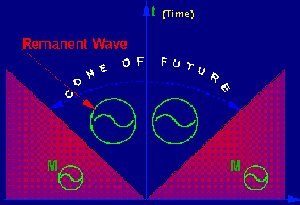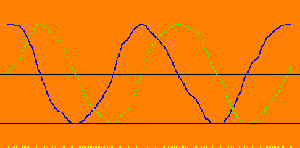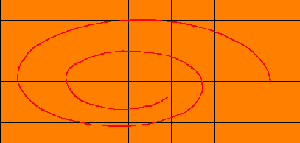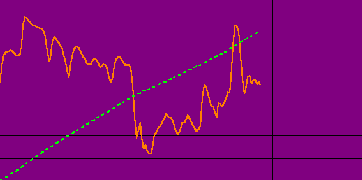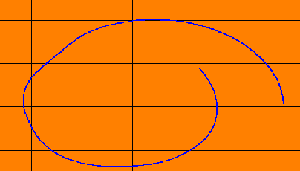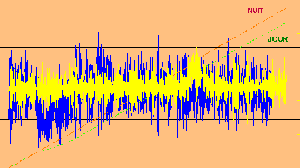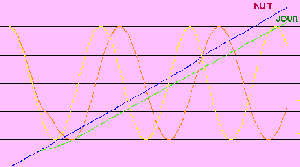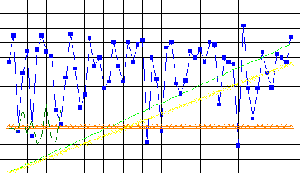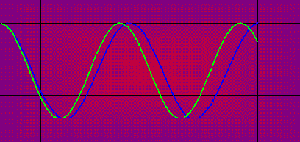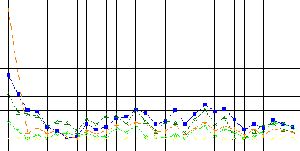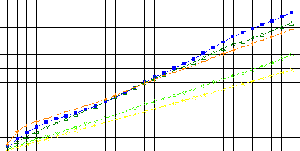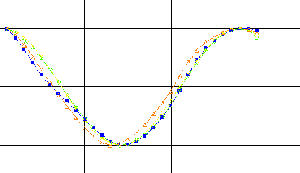From this approach, we have a
complete mathematical frame for the analysis of this remanent wave and for the
examination of the possible irradiations effects it can produce to the
surrounding remaining matter (for example the substrate of a homeopathic drug).
Of course, at this stage, it
is only a model (we take into consideration only the "mass" character of the
particle when other characters exist as well). However, a possibility to enjoin
the experimental approach exists throughout contonian statistics and the
conceptual frame in which the remanent wave is represented in the form of
contons is therefore well founded.
|
For the definition of the
contonian appearances (contons) the following method is used. From the remanent
wave, products called chronological are built and then "read" via the
help of a character (contonian appearance). By doing so, the contons are
obtained.
In practice, a conton is defined as an appearance of a dynamic system,
general mathematical notion that summarizes the approach of any type of
evolutionary system. When using this modeling, the principle consists in
considering the space of the" states" of the system, that means all
possible values of the parameters of the system, and in defining a dynamic
system as a way to pass from one state to another one. More information on the
general definition of the conton are given in the book :
"Nouvelle Economie Théorique" (Conte and al.,
1993)
(1).
|
We will now describe the
practical methods that allow to "read" a contonian phenomenon and, for
doing so, we will consider hormesis curves.
Let v be the parameter we
will call Hahnemannian parameter whose usual units are CH or DH.
We observe a quantitative
character x(u) that can be very various (optical density, death rate of a batch
of mice,...) and by using the method of the trapezes we calculate the integral
that is expressed as follows:
|
|
Int (vo, v) x(u)du = L(v)
|
This integral will be the
contonian lagrangian, so called because its typology is the same as the optic path in physics.
The aspect of the curves L(v) will be linear.
We can calculate the contonian frequency H, since
the conton is defined by the relation:
|
|
exp(i H Int (vo, v) x(u)du
|
|
and represents the point of
the circle that varies as a function of the Hahnemannian parameter according to
a circular movement:
|
|
Teta= H Int (vo, v) x(u)du
|
The gap between these two
values of H is about 2% and within the margin of error for this type of
measures.
This confirms the interpretation by the remanent wave of the activity
of the high dilutions.
Indeed, the theory foresees that the parameter
"contonian frequency" is a data that only depends on the substance put in
solution, here the nitric acid, so long as the same source of water is used for
dilutions in order to eliminate the effects due to the residual impurities of
this water or that one makes sure, for every source of water, that the
parameter measured for the first source of water remains unchanged.
The observed phenomenon is
really due to the remanent wave, that is to say to the radiation of a " white hole" left by the
disappearance of the matter in solution. This phenomenon is located at the
level of the nucleons of the solution as shown by Y. Lasne who measured the T2
parameters of the ion H+ become " super proton" by the
action of the remanent wave and of the ion O17H - also
modified by the remanent wave.
A phenomenon of remanence
exists effectively when matter disappears, that means a certain form of
"memory", but this concerns the memory of the emptiness, if one must
take a vivid expression, and we are going to see that this same phenomenon of
remanence is observed for non-aqueous solutions.
We will simply point out that
the theory due to J. Benveniste and his team, theory that the polemic
translated by the setting in evidence of the" water memory”, doesn't
permit to interpret the remanence correctly. According to this theory, the
"memory", would be due to a modification of the water dipole by the
substance in solution.
This theory is based on the
physico-mathematical calculation developed by Del Guidice (Del Guidice and al,
1988)(3) that supposes that at least a molecule of the initial
substance still remains, what is not the case when we passe the 12 CH.
Besides, this physico-mathematical
interpretation has the inconvenience to make appear the same type of field
before and after the succussion, what is not verified by the experiences
achieved by Y. Lasne in NMR.
|
This phenomenon of remanence
of the non-aqueous solutions has also been observed by Samuel Hahnemann who
showed that, if gold or silver in their natural state have no action on man,
their infinitesimal dilutions in another solid invest them with other
properties: "... from the grinding continued during one hour of a gold
grain with hundred grains of lactose in powder, results a preparation that
already has a lot of medicinal virtues.
If one continues to act until every
grain of the ultimate preparation contains a quadrillionth (10-24)
of gold grain, then we will have a medicine, in which the medicinal virtue of
gold will be so developed that it will be sufficient to take one grain, to
store it in a small bottle and to give it for
breathing during some instants to a melancholic, to whom the disgust of
life is pushed up to the point to lead him to the suicide, so that, one hour
after, this poor wretch is delivered of its bad demon and recovers the charm to
life.
(4).
|
Their statistics
is interpreted in the Theory of Ethers and is not a probabilistic statistics as
already said while beginning this
presentation.
A typical example of random phenomena, the white noise or Brownian movement, is not contonian.
A contonian process has
an"informational" content that the white noise, that " forgets" its past, doesn't have,
and its" memory" has the same nature that the one of light
(electromagnetic waves): the light from the stars keeps, after millions, or
even billions light years away, the information of the matter of the periphery
of the star.
|
The illustration of the
contonian behavior of the high dilutions effect has been tackled by M.
Bastide and col. on a model of Candida
albicans pre-treated with the 5FC at different CH.
Other experimentations are
in progress in the toxicological field that should allow us to generalize this
mathematical interpretation to other contonian characters such as mortality for
example.
The illustration of the contonian behavior of the high dilutions effect brings us to recall two
major ideas of Hahnemann. In page 275 of the book already quoted, Hahnemann
expresses as follows his 2nd natural law "A stronger dynamic disease
extincts, in a lasting manner, another less strong dynamic disease in the living organism, when the
first looks like the second as for the species."
|
These are in fact the white
holes that, while combining with the
black holes (the" toxic") lead to a resultant specter that goes from
the disappearance of the black holes (Pi phase displacement) to super
black holes (nil phase displacement )
while going through the formation of holes having all nuances of gray.
It is
this resultant that will interact with the organism and will produce the
observed effects.
Let's recall that, in astronomy, one calls "black hole" a region of the
space-time having an infinite density of matter.
The region where are localized the nucleons behaving locally in
this way, we used this terminology. We also recall that, for Hahnemann "the
medicinal substances are not dead matters; their real nature is dynamic: it is
a pure strength".
|
This mechanism, that has
been illustrated by Yves Lasne by the interaction between a hahnemanian
dilution and peroxydases, has to be brough closer to another idea already
expressed in these terms by Hahnemann in page 276 of the quoted work:"the organism, as a living unit,
cannot admit two similar dynamic diseases at the same time without the weakest
being oblige to give way to the
strongest.
However, since it tends to be affected more strongly by a medicine
than by an analogous illness, this one must necessarily leave it, and he is
then cured". In fact, it is the "Nature" and no the organism
that cannot admit the coexistence of two " similar dynamic disease".
There is an interaction between the
phases of the white and black holes.
When these phases are opposed, their
interaction leads to a nil resultant
and the patient is cured.
|
|
Acknowledgments:
|
We are pleased to thank the
personalities who helped us in this survey and more particularly
Mr. P. Dorfman
of the Dolisos Laboratory, Mrs. Professor Madeleine Bastide, Mr. Professor J.
Cambar and Mr. Y. Lasne for their attitude and the enthusiasm they testified to
undertake some experiences or "to search" in their laboratory
notebooks in order to extract some experimental results.
|
|
Bibliography
|
| 1. |
CONTE (R.R), BERLIOCCHI (H), ANDRAS (H.G.) :
Nouvelle Economie Théorique.
Editions Economica, Paris, 1993
|
| 2. |
LASNE (Y.) : L'homéopathie de/par l'information
De Natura Rerum, 1993,7,pp 95-168
|
| 3. |
DEL GUIDICE (E), PREPARATA (G.), VITTELLO (G.) : Water as a free electric dipole laser. Phy. Rev. lett., 1988, 61, pp 1085-1088.
|
| 4. |
HAHNEMANN (S.) : Etude de Médecine Homéopathique, première série.
Editions J.B Baillière, Paris, 1855, p.579.
|
| 5. |
HEINTZ (E.) : Physikalische Wirkungen Hochwerdünnter potenzierter Substanzen Die Naturwissenschaften, 1941, 29, pp.713-725.
|

